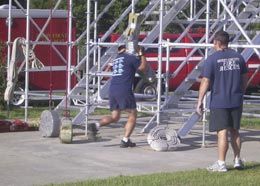 Photo Michael Medeiros Horry County (S.C.) firefighters work on their fitness. |
High levels of physical fitness are required to safely perform rescue and firefighting duties. Without this not only are the firefighters themselves at risk of injury, but the safety of both their fellow department members as well as the general public can be jeopardized.
Nationwide adherence to the Wellness/Fitness Initiative now seems to be taking place, made possible largely by the efforts of the NFPA and the IAFF in getting this information out and usable.
Now that we have established the need to increase fitness levels in the fire service, we can move on to the next level of training. The previous article gave you a generic program to start moving and get a baseline for your fitness. Changing to a more rigorous program will help improve performance and rehab on the job.
Functional Training
Most of you will have had some sort of program to follow up until now — but it’s important to change the program from time to time so that the body doesn’t get bored. To increase your performance and strength, you need to switch it up. Here’s a program to help firefighters hone in their muscular endurance and strength.
Let’s start with regular calisthenics as your warm-up for 10 minutes or so. Next, put together some endurance exercises. Here’s one that you can try:
1. Sprint from the inside of the bay to the road and back.
2. Without rest, move into unlimited pushups. This means until failure.
3. Sprint back to the road and back.
4. Now lie back on the floor and try to do some crunches until failure.
5. Sprint back to the road and return running backwards.
6. Lay flat on your stomach and do swimmers or low-back hyperextensions until failure.
7. Now rest for 2-3 minutes, and then repeat.
Job-Related Workout (Functional Circuit)
The previous exercise can be done once before your circuit, or you can try to repeat two to three times to get an overall workout. The next circuit will utilize more functional movements catered toward firefighting.
- Same as above, start with a warm-up of calisthenics for about 10 minutes
- Next, follow this next circuit all the way through. There is no start or end, just remember to continue for the time allotted. Intermediate and advanced levels will be 30 minutes of continuous movement, 20-30 seconds per task, then moving to the next station. No rest during exercise except for the moving from station to station.
- The use of full bunker gear for intermediate and SCBA for advanced is required. Substitute for weighted vest if you have one.
1. Hose Drag
Drag two sections of 1 ¾ hose for 100 feet and return.
2. Foam Bucket Shrugs
Take two filled foam buckets, stand shoulder width holding them with arms extended. Start by raising shoulders in a shrugging motion and return.
3. Long Spine Board Lifts
With a long spine board, attach one end to a ledge or a chair. Load it up with 100-175lbs of weight (whatever you can find), then secure it firmly. This exercise will be done with the proper lifting of a spine board from the ground to waist height. Squat down, grab the board with your hands, and then stand. Remember to have your back straight and lift only with your legs.
4. Extinguisher Delt Raises
With two fire extinguishers, holding them in front of you, raise them up with both arms stiff to shoulder height then return. These simulate deltoid front raises.
5. Step ups
You can do these either with actual stairs or on the back of an engine. Take an average high-rise pack onto your shoulder and step up on the tailboard then step back down. You can use the hand rail for help.
6. Ladder Climb
Take your favorite tool and ascend up a ladder that has been secured to either the outside roof or inside rafters. Climb to the top then return to the ground.
Note:
- When performing any of these fire related-activities, one of the main goals is to perform them safely and with proper form.
- While at a station, try to continuously repeat movements until allotted time elapses.
- High-rise packs can be constructed with 1 ¾ -2 ½ inch hose.
- Stations are better utilized if going from upper or lower body exercise to the other, which gives the part rest.
- You can substitute charged hose line for a small section of hose and attach it to either a wooden sled (weighted) or an object to drag for resistance.
- Finish any exercise with static stretching. Hold stretches for 20 seconds at a time and repeat. NEVER lock elbows or knees.
- Be creative!
Conclusion
Your program can be manipulated and changed as often as you want. More often than not, most people stay with a program anywhere between four to six weeks. By that time, the body gets too used to it and doesn’t seem to be able to build off of it. So changing your workouts and programs will help development as well as decrease boredom. No one program is better than another — find what works for you and keep with it. You will only get back what you put in to it!
Michael Medeiros will be speaking and teaching at the South Carolina State Health & Safety Conference on Jan 11., 2008. For more details, go to www.scfa.state.sc.us











